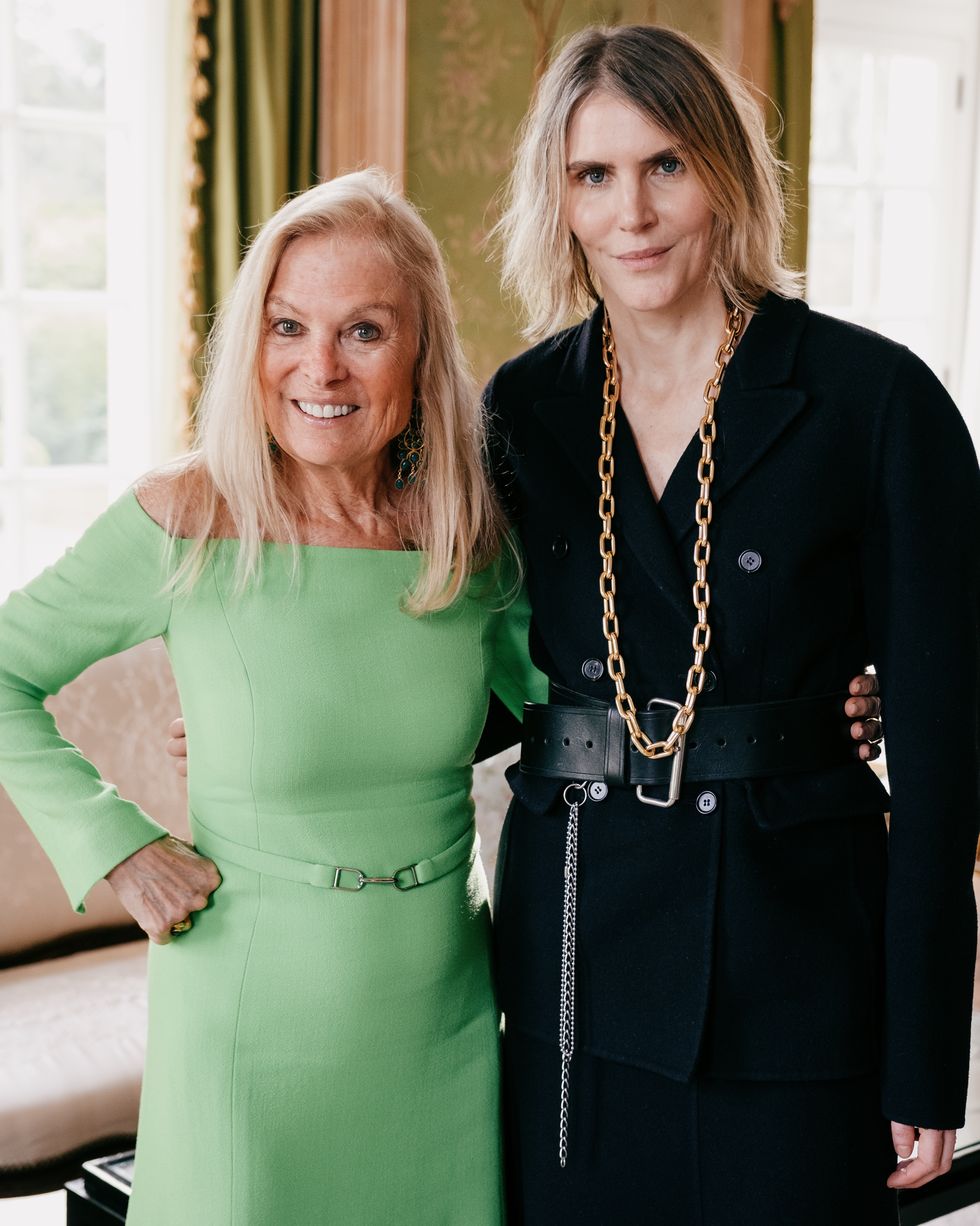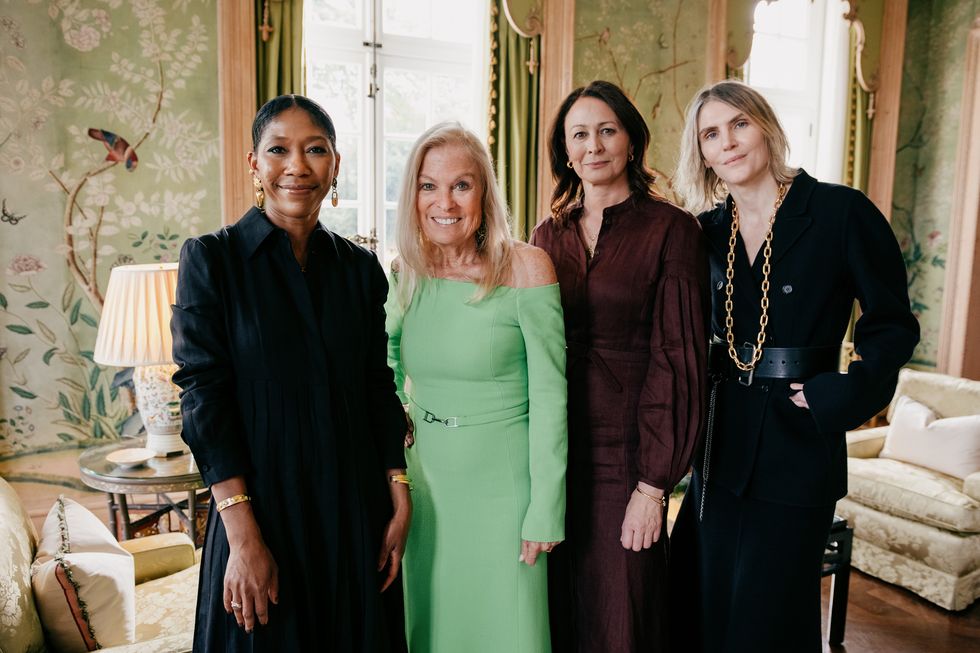Gabriela Hearst, Caroline Rush, and Kenya Hunt Talk Fashion and Sustainability in London
Earth Month is as good a time as any to reflect on the progress being made in the ongoing battle against the climate crisis and environmental challenges that dominate the world’s ever-escalating headlines. In recent years, sustainability has shed its reputation as a progressive buzzword and become a critical focus area for individuals, governments, and corporations across the globe, as they increasingly recognize the importance of making permanent changes to slow carbon emissions and the pace of global warming. In particular, this has also sparked an era of reassessment for the fashion industry, which produces between 100 and 150 billion items a year, of which only 80 percent are sold.
For founder and creative director Gabriela Hearst, it’s her humble beginnings growing up on a ranch in Uruguay that introduced her to the importance of sustainable practices in fashion. “I’m not revolutionary, I’m just using practices from the past,” the designer explained during a panel conversation with ELLE UK editor-in-chief Kenya Hunt and British Fashion Council CEO Caroline Rush in London last night.
The trio met at the residence of United States Ambassador Jane Hartley to discuss fashion’s commitment to sustainability and what big businesses can learn from small independent companies. The event was attended by numerous sustainability advocates, designers, and CEOs in the industry, including Completedworks jewelry designer Anna Jewsbury, Princess Eugenie, Torishéju Dumi, Tolu Coker, eBay’s pre-loved style director Amy Bannerman, and more.
“It’s going to take all of us working together to make a difference,” Hartley said of sustainability in fashion during her foreword at the event. “Globally, fashion is responsible for 10 percent of carbon emissions, more than international flights and maritime shipping combine…this means we have a big opportunity, in addition to a big challenge, to change.”
With fashion contributing 1.3 million jobs to the U.K. economy alone and considering the fact that the industry is worth around $1.7 trillion globally, Hartley—who wore a vintage green off-the-shoulder Gabriela Hearst dress from the online marketplace The RealReal for the event—noted that “changing trends in fashion will have a major impact across the world.” One such change comes with the ambassador’s announcement that Hearst is funding not one, but two new scholarship positions at the University of the Arts London and the London College of Fashion with David Carey, Hearst’s senior vice president of public affairs and communications. “This is an issue very close to my heart, because just as much as I want change, I believe that change has to provide a better future for young people,” Hartley noted.
Sustainability has always formed the bedrock of Hearst’s future-focussed ethos. It saw Hearst UK win the honor of Sustainability Strategy of the Year 2022 at the Newspaper and Magazine Awards. The London office, known as House of Hearst, uses 100-percent-certified renewable energy with zero waste to landfill, and its New York City HQ, Hearst Tower, is the first building to receive both Gold and Platinum LEED certifications. Moreover, 100 percent of the paper fiber that Hearst Magazines and Hearst Newspapers purchase is sourced in an ecologically responsible matter.
Hearst’s uncompromising commitment to sustainability is as renowned as her namesake label, which she launched in 2015 before taking the helm at Chloé in 2023—a position from which she stepped down last year. For years, her runway shows have been a shining example of the power of using deadstock fabrics and eliminating plastic, including her spring/summer 2020 collection, which became the first-ever carbon neutral runway show. Last month, the designer received the Time Earth Award, and just last week, the San Francisco Ballet premiered a female-first version of Carmen with costumes designed by Gabriela.
“With privilege comes responsibility,” Hearst began the conversation, noting her beginnings growing up in South America where her family would live off the grid and use only one hour’s worth of energy from a generator at night. “I’ve learned to live in these two worlds…I have to go to work thinking of the realities of others and thinking that, because of climate and conflict, we’re going to be relocating 125 million refugees, 50 of them being children, and over 450 million people living in conflict zones.” Regarding the widely held view that sustainability is detrimental to creativity, she added: “You think it will became weaker, but it’s actually stronger—you don’t sacrifice anything.”
Rush, who became the CEO of the British Fashion Council in April 2009 and has welcomed the return of Matthew Williamson, Burberry, and Mulberry, to London Fashion Week during her tenure, explained that collaboration is fundamental in tackling the biggest challenges that fashion faces in regards to sustainability. “The way that the fashion industry used to operate is that…you’d have your brand, you wouldn’t share knowledge, suppliers, anything. [The increased focus on] sustainability has really brought together the industry in terms of opening up its contact book, thinking about how it can do things differently and sharing case studies,” she added.
With a “passion for renewable energy,” Hearst went on to discuss the opportunities that open with fusion, which generates electricity using heat from nuclear fusion reactions. “Nuclear has had bad PR,” she joked, noting that Chloé produced a show powered by fusion energy in 2022. “The idea that you can deweaponize energy is remarkable, and it gives me so much hope…it has the ability to really solve the big dependency that we have in fossil fuels. It’s not the only solution, but it’s one of them.” She explained that one of her reasons she took her previous role at Chloé was due to seven years of research and development in this area, which she knew would be valuable to the Richemont Group-owned brand. “Chloé was in the perfect position, because they were looking for change, and change only happens when a lot of people want it,” she added, citing that, by the time she left the brand, her sustainability team had grown from a one-person team to a group of 13.
During the conversation, Hearst, Rush, and Hunt also discussed the importance of “reverse mentoring,” where small businesses are helping to educate large businesses about sustainability. “The image you create isn’t only important, rather the message… I value efficient businesses more than big businesses,” added Hearst, with Rush stressing the financial benefits of improving sustainability in fashion. “If you maximie the utiliation of resources, you’re saving money,” she explained, listing over-production and waste through design as the big issues the industry currently faces.
Looking ahead to the future, Hearst mentioned that, as a designer, she believes she’s a “guardian” for the next generation. “It’s their world, not ours,” she said, stressing her passion for “protecting women.” While discussing fabric innovation—for example, using silver linings in clothes that protect women’s reproductive organs from mobile phone radiation—Hearst said: “I love dressing women, I love framing women, I love empowering women—I know the power of dressing a woman.”
Hearst and Rush agreed that, despite damning news about the state of the environment, they both find hope for the future through scientists, brilliant minds, and “the human spirit.” “Every time there’s a cheap option of a lower price from a company, you have to remember that somebody else is picking up the bill now, or in the next generation,” Hearst warned.
While it’s clear that society is aware of the environmental impact of carbon emissions, and efforts have been made to improve investments into electric cards and transportation around the world, Hartley is concerned the conversation about fashion’s impact on sustainability is lagging due to a failure to adequately communicate its vital impact and meaning.
“On a micro level, people want to protect their environment,” she told ELLE UK prior to the panel. “People are aware that there’s a problem, but I think in many cases, individuals don’t really know what to do about it,” she added, emphasizing the importance of checking a piece of clothing’s label, investigating where companies are producing the items, and looking at their green efforts. According to Hartley, promoting sustainable fashion involves two steps: “understanding its problem, and understanding what individuals and groups can do to solve it.”
Hartley has served as the U.S. ambassador to the United Kingdom of Great Britain and Northern Ireland since 2022, and previously served as the U.S. ambassador to France and Monaco from 2014 until 2017 during the Barack Obama administration.
She has long had an interest in fashion [“I’ve always loved it…I had this hot-pink coat I used to wear everywhere but now I tend to be more of a black or white person: black in the winter and white in the summer”], with a love for sartorial design running through her family. Her daughter Kate is the highest-ranking woman in country for Italian luxury brand Loro Piana. “When we look at fashion, it’s important to remember that fashion is a business,” Hartley said of the industry’s economic-driving credentials, listing the way it creates jobs and enables the next generation of creatives to receive training.
An avid supporter of Hearst and designer Tory Burch, Hartley is a champion of women both in and outside of the realms of fashion—a trait that is needed more than ever. According to a study from the Pew Research Center, the gender pay gap has barely closed in the United States in the past two decades, and in 2022, women typically earned 82 cents for every dollar earned by men. Hartley recalled a time when she was on the board of directors at an executive firm and pushed her employers to invite more women to the table. “It means getting more women on boards, in top slots and in positions like CFO, CEO, and CMO,” she said, before adding: “When I watched their internal [hiring] process, it was clear it was meant to keep women out.” During the search for a new CEO, Hartley recalled the “fairly narrow” list of qualifications required for the position, which resulted in around 98 percent of applicants being male. “If you’re willing to look outside of the box, you’ve got some fantastic women. People have to start thinking about leadership and pools of talent differently.”
From her own experience as the second female ambassador to France in over 200 years, and the second female ambassador to the U.K. in the last 50 years, Hartley knows all too well the importance of giving women prominence in positions of power. “When I walk down the hall in the embassy, there are portraits of all the ambassadors and I think, we can do better than this…we have to do better than this.”
Ensuring young people, especially women, receive adequate training is vital in ensuring growth, Hartley added. “Companies have a responsibility to do well, but they also have a responsibility to do good,” she said. “Young people are being left behind with an underemployment problem, and many of those people are women because they might have left the workplace for family responsibilities and might not have kept up with their skills…having a good income and a good future is really important, especially as we move towards AI, we have to make sure people are trained.”
And as a woman in politics who keenly remembers the misogyny presidential candidate Hillary Clinton faced in 2016 (“she was delivering speeches that were critically important on NATO and people were talking about her suit”), Hartley admits she isn’t immune to feeling frustrated when journalists comment on her appearance over her politics. “When I was in France, there was one person—who will remain nameless—who was constantly talking about my hair….It drove me nuts because no one would ever say that to a man.”
Ahead of election season, Harley noted the importance of sustainability for the Democratic Party. “I think a couple of the constituencies that care deeply about sustainability are going to be critical to swinging the vote, whether it’s young people or women in the suburbs,” she said.
As we’ve seen with the Fashion Sustainability and Social Accountability Act, which is currently pending in the New York State Assembly and will require companies to report on their impacts and reduce carbon emissions, Hartley underscored that “you need political action, and then government action” to make a change. “Because government action is the only way you’re going to get the big picture, otherwise it’s too individualistic.”

Katie O’Malley is the Site Director on ELLE UK. On a daily basis you’ll find Katie managing all digital workflow, editing site, video and newsletter content, liaising with commercial and sales teams on new partnerships and deals (eg Nike, Tiffany & Co., Cartier etc), implementing new digital strategies and compiling in-depth data traffic, SEO and ecomm reports. In addition to appearing on the radio and on TV, as well as interviewing everyone from Oprah Winfrey to Rishi Sunak PM, Katie enjoys writing about lifestyle, culture, wellness, fitness, fashion, and more.





